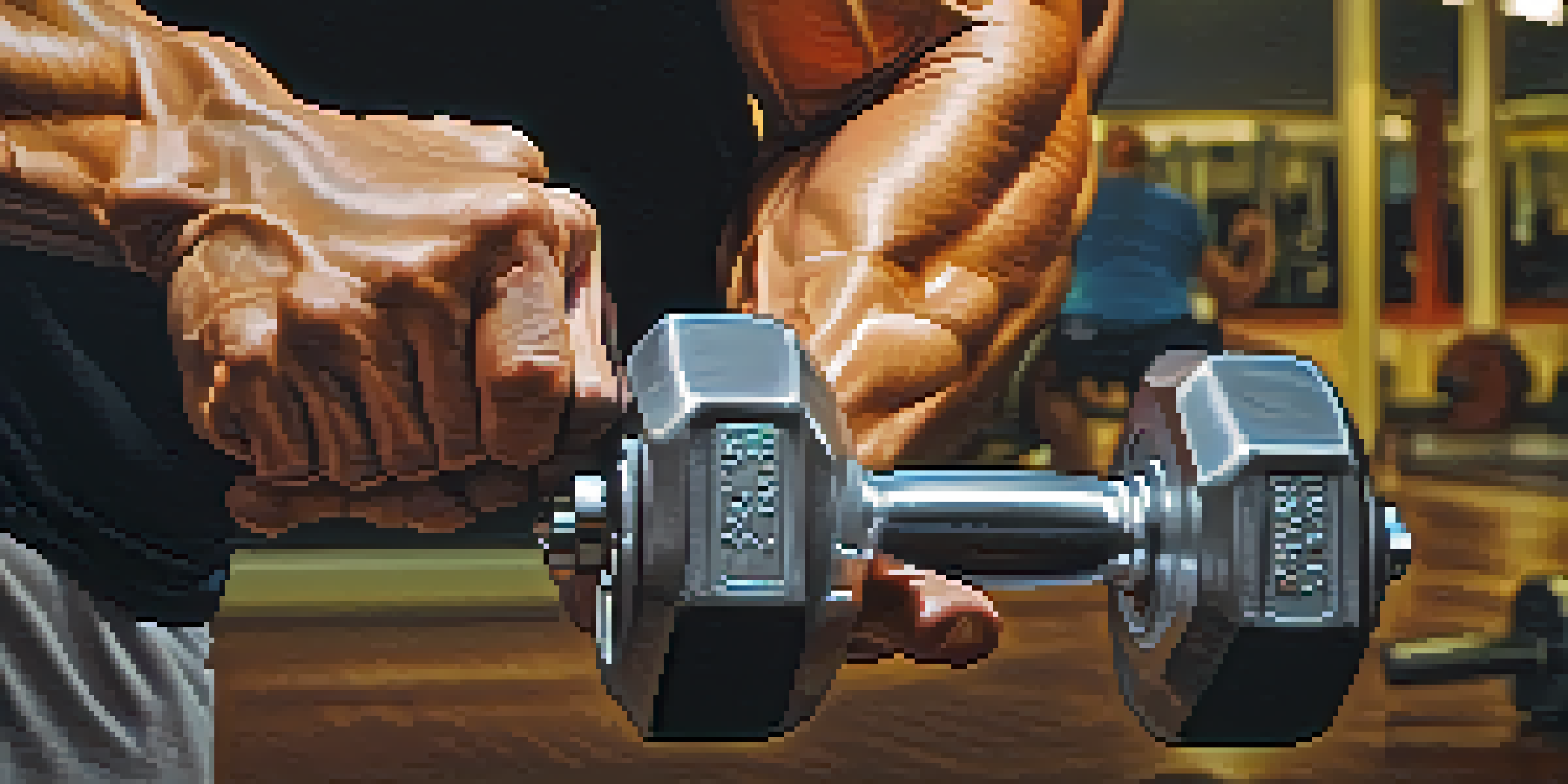The Science Behind Muscle Hypertrophy in Strength Training

Understanding Muscle Hypertrophy and Its Importance
Muscle hypertrophy refers to the increase in muscle size resulting from strength training. It’s essential for anyone looking to improve their physical performance, whether in sports or daily activities. By understanding hypertrophy, athletes and fitness enthusiasts can tailor their training for optimal results.
Strength does not come from physical capacity. It comes from an indomitable will.
This growth occurs primarily through two mechanisms: myofibrillar hypertrophy, which increases the size of muscle fibers, and sarcoplasmic hypertrophy, which enhances the volume of the fluid that surrounds these fibers. Both types contribute to overall strength and endurance, making hypertrophy a critical focus in any training program.
Ultimately, understanding muscle hypertrophy can help individuals set realistic goals and track their progress. It’s not just about lifting heavier weights; it’s about knowing how your body responds and adapting your regimen accordingly.
The Role of Mechanical Tension in Muscle Growth
Mechanical tension is one of the primary drivers of muscle hypertrophy. When you lift weights, the tension created on your muscle fibers sends signals to your body to adapt by growing. This is why progressive overload—gradually increasing the weight you lift—is crucial for muscle growth.

Think of mechanical tension like stretching a rubber band. The more you stretch it, the more potential it has to snap back into shape, or in this case, grow stronger and bigger. Without adequate tension, your muscles won’t receive the signals necessary for growth.
Muscle Growth Requires Tension
Mechanical tension from lifting weights is crucial for signaling muscle growth through adaptation.
In practical terms, this means incorporating varied rep ranges and weights in your strength training routine. By challenging your muscles through different forms of tension, you can stimulate growth more effectively.
The Importance of Muscle Damage for Hypertrophy
Muscle damage occurs when you push your muscles beyond their usual limits, leading to tiny tears in the fibers. This damage is actually beneficial for hypertrophy, as it triggers the body’s repair processes, leading to muscle growth. This is often why you feel sore after a tough workout!
The only bad workout is the one that didn't happen.
When your body repairs these tiny tears, it not only heals but often adds more muscle fibers to withstand future strain. This process is akin to building a stronger structure after identifying its weaknesses—your muscles adapt and grow to handle the increased load.
To maximize muscle damage, consider incorporating eccentric movements (the lowering phase of an exercise) into your routine. These movements create more micro-tears and can lead to greater muscle growth when paired with proper recovery.
The Role of Metabolic Stress in Muscle Growth
Metabolic stress refers to the build-up of metabolites like lactate in your muscles during intense exercise. This phenomenon is a significant factor in stimulating muscle hypertrophy, as it creates the 'pump' feeling many weightlifters chase. This sensation is not just for show; it signals your body to adapt and grow.
When your muscles are under stress, they release hormones and growth factors that promote muscle repair and growth. Think of metabolic stress as the body’s alarm system—when it detects that your muscles are working hard, it kicks into gear to ensure they can handle future challenges.
Nutrition Fuels Muscle Repair
A balanced diet rich in protein and carbohydrates supports muscle repair and growth after workouts.
To harness metabolic stress, consider using techniques like drop sets or circuit training, which keep your muscles under tension for longer periods. This can lead to enhanced muscle growth alongside the effects of mechanical tension and muscle damage.
Nutrition’s Essential Role in Muscle Hypertrophy
What you eat plays a crucial role in muscle hypertrophy. Consuming the right balance of macronutrients—proteins, carbohydrates, and fats—fuels your workouts and aids recovery. Among these, protein is vital, as it provides the building blocks (amino acids) necessary for muscle repair and growth.
Aim for a protein-rich diet, including sources like lean meats, dairy, legumes, and nuts to support your training. For many, a common recommendation is to consume around 1.6 to 2.2 grams of protein per kilogram of body weight, depending on activity levels.
In addition to protein, don’t overlook carbohydrates, which help replenish energy stores and promote recovery. A well-rounded diet supports your training and maximizes the benefits of your hard work in the gym.
The Significance of Recovery in Muscle Hypertrophy
Recovery is often overlooked but is just as important as the training itself when it comes to muscle hypertrophy. Your muscles need time to repair and grow stronger after intense workouts, and this process primarily happens during rest. Without sufficient recovery, you risk overtraining and stalling your progress.
Consider recovery as the downtime your muscles need to reflect on their workout experience. Just as a sponge needs time to soak up water after being squeezed, your muscles need adequate rest to fully benefit from the stresses placed upon them.
Recovery is Key for Progress
Adequate recovery time is essential for muscles to repair and grow stronger, preventing overtraining.
Incorporating rest days, sleep, and active recovery into your routine can enhance your results significantly. Don’t underestimate the power of taking a step back to allow your body to build itself stronger.
Practical Tips for Maximizing Muscle Hypertrophy
To maximize muscle hypertrophy, consider implementing a structured training program that includes all the discussed elements. This means focusing on exercises that provide mechanical tension, induce muscle damage, and create metabolic stress. Compound movements like squats, deadlifts, and bench presses are excellent choices for this.
Additionally, track your progress and adjust your regimen as needed. Keeping a training log can help you identify what works best for your body and ensure you’re continuously challenging yourself. Remember, consistency is key in seeing results.

Lastly, don’t forget about the importance of mindset. Approach your training with a positive attitude and a willingness to learn. Embrace the journey of growth and be patient; hypertrophy takes time, but the rewards are well worth the effort.